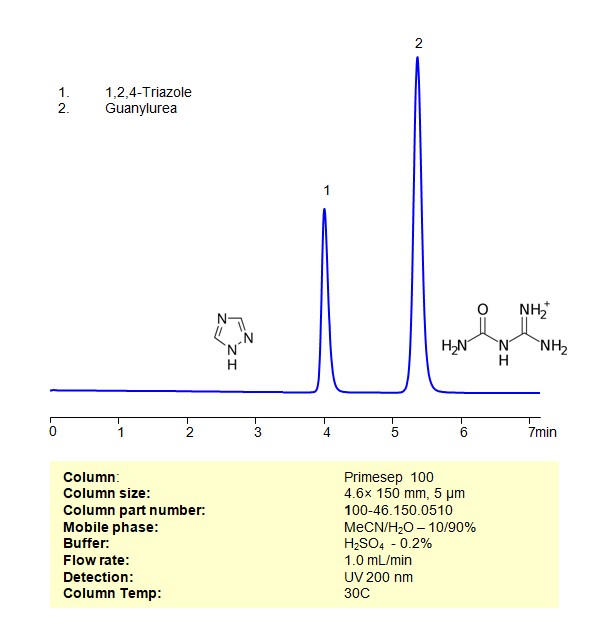HPLC Method for Analysis of Guanylurea, 1,2,4-Triazole on Primesep 100 by SIELC Technologies

High Performance Liquid Chromatography (HPLC) Method for Analysis of Guanylurea, 1,2,4-Triazole
Guanylurea, also known as guanidylurea, is a chemical compound with the molecular formula (C_3H_7N_5O). It is derived from guanidine and urea, and it has interesting applications in the field of chemistry and materials science.
- Crystal Growth: Guanylurea is known for its use in crystal growth processes. It has been utilized as an additive in solution to control and promote the growth of certain crystals, including organic and inorganic crystals. Guanylurea is part of the broader field of crystal engineering, where researchers explore the design and synthesis of crystalline materials with specific properties. The ability of guanylurea to form hydrogen bonds makes it relevant in this context.
- Hydrogen Bonding Studies: Due to its unique structure, guanylurea has been studied for its hydrogen bonding properties, which are important in various chemical and biological processes.The presence of amino groups in guanylurea allows it to participate in hydrogen bonding interactions, which are crucial in determining the structure and properties of molecular assemblies.
It’s important to note that guanylurea’s applications are primarily in the realm of crystal engineering and related studies. Its ability to participate in hydrogen bonding interactions makes it a valuable component in the design and manipulation of crystalline materials for various purposes.
1,2,4-triazole is a heterocyclic compound with a unique five-membered ring structure. Its versatility, biological activities, and ability to coordinate with metal ions make it a compound of interest in various scientific and medicinal applications.
The 1,2,4-triazole and Guanylurea be retained, separated and analyzed using a Primesep 100 mixed-mode stationary phase column. The analysis employs an isocratic method with a simple mobile phase comprising water, acetonitrile (MeCN), and sulfuric acid as a buffer. This method allows for detection using UV at 200 nm
| Column | Primesep 100, 4.6 x 150 mm, 5 µm, 100 A, dual ended |
| Mobile Phase | MeCN/H2O – 10/90% |
| Buffer | H2SO4 -0.2% |
| Flow Rate | 1.0 ml/min |
| Detection | UV 200 nm |
| Samples | Guanylurea – 0.77mg/mL 1,2,4-Triazole – 3.9mg/mL |
| Injection volume | 3 µl |
| LOD* | Guanylurea – 5 ppb 1,2,4-Triazole – 25 ppb |
| Class of Compounds | Aromatic amines, Ureas |
| Analyzing Compounds | Guanylurea, 1,2,4-Triazole |
Application Column
Primesep 100
Column Diameter: 4.6 mm
Column Length: 150 mm
Particle Size: 5 µm
Pore Size: 100 A
Column options: dual ended
Guanylurea





